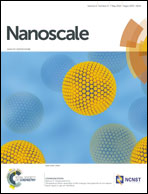Palladium–phosphorus/sulfur nanoparticles (NPs) decorated on graphene oxide: synthesis using the same precursor for NPs and catalytic applications in Suzuki–Miyaura coupling†
Abstract
PdP2 and Pd4S nanoparticles (NPs) (size: ∼2–6 and 9–15 nm respectively) have been prepared for the first time from a single source precursor complex [Pd(L)Cl2] (1) by its one pot thermolysis at 200 °C in TOP and OA/ODE (1 : 1) respectively. These NPs were stirred with graphene oxide (GO) at room temperature to prepare NP composites, GO–PdP2 and GO–Pd4S. The GO–PdP2 NPs have been synthesized for the first time. The thioether ligand L prepared by reaction of 1,3-dibromo-2-propanol with the in situ generated PhSNa reacts with [PdCl2(CH3CN)2] in CH3CN at 70 °C resulting in 1. The L and 1 have been characterized by 1H and 13C{1H} NMR and HR-MS. The single crystal structure of 1 determined by X-ray diffraction reveals nearly square planar geometry around the Pd metal centre. The catalytic activities of two palladium nano-phases having phosphorus and sulphur respectively as a co-constituent for Suzuki–Miyaura coupling have been found to be exceptionally different, as PdP2 nanoparticles (NPs) grafted on graphene oxide (GO–PdP2) are significantly more efficient than Pd4S NPs grafted on GO. Without grafting PdP2 and Pd4S both have low efficiency. This is the first report comparing the influence of P and S on the catalytic activity of Pd NPs. TEM, SEM-EDX and powder-XRD have been used to authenticate all NPs. The GO–PdP2 NPs have been found to be efficient catalysts for Suzuki–Miyaura coupling reactions (yield up to 96% in 30 min) at room temperature to 80 °C. Their recyclability has been found up to 6 cycles. In contrast, GO–Pd4S NPs are little active in comparison with GO–PdP2 NPs. The size of NPs and their distribution on GO appear to be key factors affecting the catalytic efficiency of the composite NPs. Leaching of Pd from GO–PdP2 NPs contributes significantly to the catalysis as evidenced by the three phase test, hot-filtration and recycling experiments. The catalysis is almost homogeneous.


 Please wait while we load your content...
Please wait while we load your content...